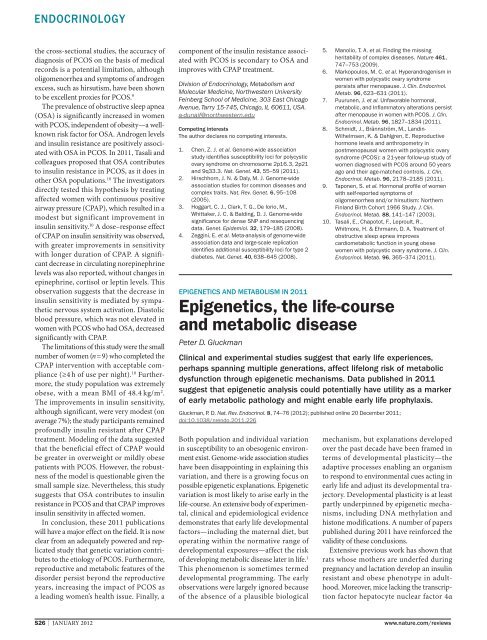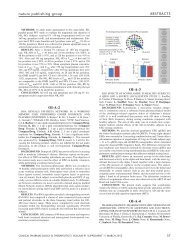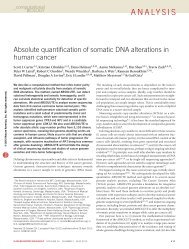open access: Nature Reviews: Key Advances in Medicine
open access: Nature Reviews: Key Advances in Medicine
open access: Nature Reviews: Key Advances in Medicine
Create successful ePaper yourself
Turn your PDF publications into a flip-book with our unique Google optimized e-Paper software.
ENDOCRINOLOGY<br />
the cross-sectional studies, the accuracy of<br />
diagnosis of PCOS on the basis of medical<br />
records is a potential limitation, although<br />
oligo menorrhea and symptoms of androgen<br />
excess, such as hirsutism, have been shown<br />
to be excellent proxies for PCOS. 9<br />
The prevalence of obstructive sleep apnea<br />
(OSA) is significantly <strong>in</strong>creased <strong>in</strong> women<br />
with PCOS, <strong>in</strong>dependent of obesity—a wellknown<br />
risk factor for OSA. Androgen levels<br />
and <strong>in</strong>sul<strong>in</strong> resistance are positively associated<br />
with OSA <strong>in</strong> PCOS. In 2011, Tasali and<br />
colleagues proposed that OSA contributes<br />
to <strong>in</strong>sul<strong>in</strong> resistance <strong>in</strong> PCOS, as it does <strong>in</strong><br />
other OSA populations. 10 The <strong>in</strong>vestigators<br />
directly tested this hypothesis by treat<strong>in</strong>g<br />
affected women with cont<strong>in</strong>uous positive<br />
airway pressure (CPAP), which resulted <strong>in</strong> a<br />
modest but significant improvement <strong>in</strong><br />
<strong>in</strong>sul<strong>in</strong> sensitivity. 10 A dose–response effect<br />
of CPAP on <strong>in</strong>sul<strong>in</strong> sensitivity was observed,<br />
with greater improvements <strong>in</strong> sensitivity<br />
with longer duration of CPAP. A significant<br />
decrease <strong>in</strong> circulat<strong>in</strong>g norep<strong>in</strong>ephr<strong>in</strong>e<br />
levels was also reported, without changes <strong>in</strong><br />
ep<strong>in</strong>ephr<strong>in</strong>e, cortisol or lept<strong>in</strong> levels. This<br />
observation suggests that the decrease <strong>in</strong><br />
<strong>in</strong>sul<strong>in</strong> sensitivity is mediated by sympathetic<br />
nervous system activation. Diastolic<br />
blood pressure, which was not elevated <strong>in</strong><br />
women with PCOS who had OSA, decreased<br />
significantly with CPAP.<br />
The limitations of this study were the small<br />
number of women (n = 9) who completed the<br />
CPAP <strong>in</strong>tervention with acceptable compliance<br />
(≥4 h of use per night). 10 Furthermore,<br />
the study population was extremely<br />
obese, with a mean BMI of 48.4 kg/m 2 .<br />
The improvements <strong>in</strong> <strong>in</strong>sul<strong>in</strong> sensitivity,<br />
although significant, were very modest (on<br />
average 7%); the study par ticipants rema<strong>in</strong>ed<br />
profoundly <strong>in</strong>sul<strong>in</strong> resistant after CPAP<br />
treatment. Model<strong>in</strong>g of the data suggested<br />
that the beneficial effect of CPAP would<br />
be greater <strong>in</strong> overweight or mildly obese<br />
patients with PCOS. How ever, the robustness<br />
of the model is questionable given the<br />
small sample size. Never the less, this study<br />
suggests that OSA con tributes to <strong>in</strong>sul<strong>in</strong><br />
resistance <strong>in</strong> PCOS and that CPAP improves<br />
<strong>in</strong>sul<strong>in</strong> sensitivity <strong>in</strong> affected women.<br />
In conclusion, these 2011 publications<br />
will have a major effect on the field. It is now<br />
clear from an adequately powered and replicated<br />
study that genetic variation contributes<br />
to the etiology of PCOS. Furthermore,<br />
reproductive and metabolic features of the<br />
dis order persist beyond the reproductive<br />
years, <strong>in</strong>creas<strong>in</strong>g the impact of PCOS as<br />
a lead<strong>in</strong>g women’s health issue. F<strong>in</strong>ally, a<br />
component of the <strong>in</strong>sul<strong>in</strong> resistance associated<br />
with PCOS is secondary to OSA and<br />
improves with CPAP treatment.<br />
Division of Endocr<strong>in</strong>ology, Metabolism and<br />
Molecular Medic<strong>in</strong>e, Northwestern University<br />
Fe<strong>in</strong>berg School of Medic<strong>in</strong>e, 303 East Chicago<br />
Avenue, Tarry 15‑745, Chicago, IL 60611, USA.<br />
a‑dunaif@northwestern.edu<br />
Compet<strong>in</strong>g <strong>in</strong>terests<br />
The author declares no compet<strong>in</strong>g <strong>in</strong>terests.<br />
1. Chen, Z. J. et al. Genome-wide association<br />
study identifies susceptibility loci for polycystic<br />
ovary syndrome on chromosome 2p16.3, 2p21<br />
and 9q33.3. Nat. Genet. 43, 55–59 (2011).<br />
2. Hirschhorn, J. N. & Daly, M. J. Genome-wide<br />
association studies for common diseases and<br />
complex traits. Nat. Rev. Genet. 6, 95–108<br />
(2005).<br />
3. Hoggart, C. J., Clark, T. G., De Iorio, M.,<br />
Whittaker, J. C. & Bald<strong>in</strong>g, D. J. Genome-wide<br />
significance for dense SNP and resequenc<strong>in</strong>g<br />
data. Genet. Epidemiol. 32, 179–185 (2008).<br />
4. Zegg<strong>in</strong>i, E. et al. Meta-analysis of genome-wide<br />
association data and large-scale replication<br />
identifies additional susceptibility loci for type 2<br />
diabetes. Nat. Genet. 40, 638–645 (2008).<br />
5. Manolio, T. A. et al. F<strong>in</strong>d<strong>in</strong>g the miss<strong>in</strong>g<br />
heritability of complex diseases. <strong>Nature</strong> 461,<br />
747–753 (2009).<br />
6. Markopoulos, M. C. et al. Hyperandrogenism <strong>in</strong><br />
women with polycystic ovary syndrome<br />
persists after menopause. J. Cl<strong>in</strong>. Endocr<strong>in</strong>ol.<br />
Metab. 96, 623–631 (2011).<br />
7. Puurunen, J. et al. Unfavorable hormonal,<br />
metabolic, and Inflammatory alterations persist<br />
after menopause <strong>in</strong> women with PCOS. J. Cl<strong>in</strong>.<br />
Endocr<strong>in</strong>ol. Metab. 96, 1827–1834 (2011).<br />
8. Schmidt, J., Brännström, M., Land<strong>in</strong>-<br />
Wilhelmsen, K. & Dahlgren, E. Reproductive<br />
hormone levels and anthropometry <strong>in</strong><br />
postmenopausal women with polycystic ovary<br />
syndrome (PCOS): a 21-year follow-up study of<br />
women diagnosed with PCOS around 50 years<br />
ago and their age-matched controls. J. Cl<strong>in</strong>.<br />
Endocr<strong>in</strong>ol. Metab. 96, 2178–2185 (2011).<br />
9. Taponen, S. et al. Hormonal profile of women<br />
with self-reported symptoms of<br />
oligomenorrhea and/or hirsutism: Northern<br />
F<strong>in</strong>land Birth Cohort 1966 Study. J. Cl<strong>in</strong>.<br />
Endocr<strong>in</strong>ol. Metab. 88, 141–147 (2003).<br />
10. Tasali, E., Chapotot, F., Leproult, R.,<br />
Whitmore, H. & Ehrmann, D. A. Treatment of<br />
obstructive sleep apnea improves<br />
cardiometabolic function <strong>in</strong> young obese<br />
women with polycystic ovary syndrome. J. Cl<strong>in</strong>.<br />
Endocr<strong>in</strong>ol. Metab. 96, 365–374 (2011).<br />
EPIGENETICS AND METABOLISM IN 2011<br />
Epigenetics, the life-course<br />
and metabolic disease<br />
Peter D. Gluckman<br />
Cl<strong>in</strong>ical and experimental studies suggest that early life experiences,<br />
perhaps spann<strong>in</strong>g multiple generations, affect lifelong risk of metabolic<br />
dysfunction through epigenetic mechanisms. Data published <strong>in</strong> 2011<br />
suggest that epigenetic analysis could potentially have utility as a marker<br />
of early metabolic pathology and might enable early life prophylaxis.<br />
Gluckman, P. D. Nat. Rev. Endocr<strong>in</strong>ol. 8, 74–76 (2012); published onl<strong>in</strong>e 20 December 2011;<br />
doi:10.1038/nrendo.2011.226<br />
Both population and <strong>in</strong>dividual variation<br />
<strong>in</strong> sus ceptibility to an obesogenic environment<br />
exist. Genome-wide association studies<br />
have been disappo<strong>in</strong>t<strong>in</strong>g <strong>in</strong> expla<strong>in</strong><strong>in</strong>g this<br />
variation, and there is a grow<strong>in</strong>g focus on<br />
possible epigenetic explanations. Epigenetic<br />
variation is most likely to arise early <strong>in</strong> the<br />
life-course. An extensive body of experimental,<br />
cl<strong>in</strong>i cal and epidemiological evidence<br />
demon strates that early life develop mental<br />
factors— <strong>in</strong>clud<strong>in</strong>g the maternal diet, but<br />
operat<strong>in</strong>g with<strong>in</strong> the normative range of<br />
develop mental exposures—affect the risk<br />
of develop<strong>in</strong>g meta bolic disease later <strong>in</strong> life. 1<br />
This phe nomenon is sometimes termed<br />
developmental programm<strong>in</strong>g. The early<br />
observations were largely ignored because<br />
of the absence of a plausible biological<br />
mechanism, but explana tions developed<br />
over the past decade have been framed <strong>in</strong><br />
terms of developmental plasticity—the<br />
adaptive processes enabl<strong>in</strong>g an organism<br />
to respond to environmental cues act<strong>in</strong>g <strong>in</strong><br />
early life and adjust its develop mental trajectory.<br />
Developmental plasticity is at least<br />
partly underp<strong>in</strong>ned by epigenetic mechanisms,<br />
<strong>in</strong>clud<strong>in</strong>g DNA methylation and<br />
histone modifications. A number of papers<br />
published dur<strong>in</strong>g 2011 have re <strong>in</strong>forced the<br />
validity of these conclusions.<br />
Extensive previous work has shown that<br />
rats whose mothers are underfed dur<strong>in</strong>g<br />
preg nancy and lactation develop an <strong>in</strong>sul<strong>in</strong><br />
resis tant and obese phenotype <strong>in</strong> adulthood.<br />
Moreover, mice lack<strong>in</strong>g the transcription<br />
factor hepatocyte nuclear factor 4α<br />
S26 | JANUARY 2012 www.nature.com/reviews








